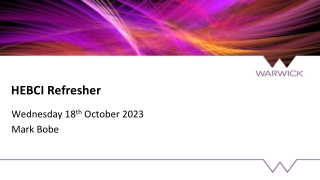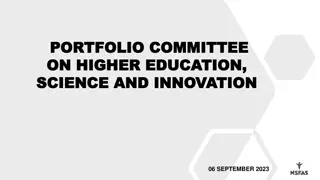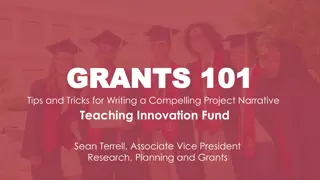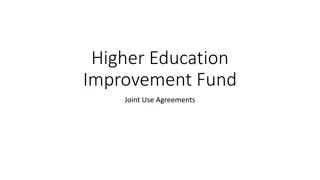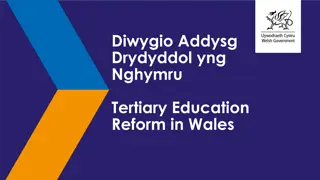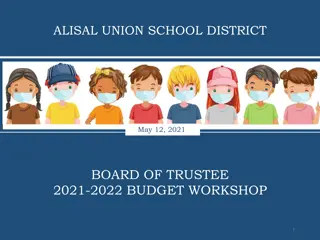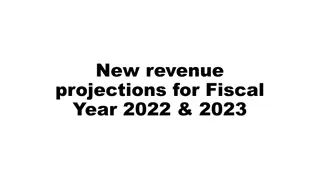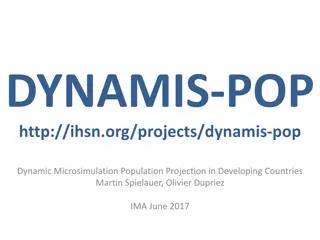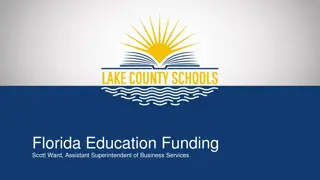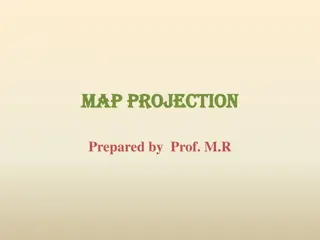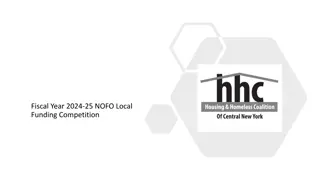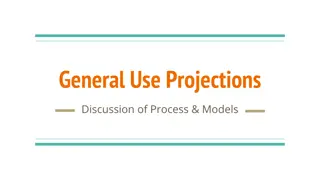Overview of 2023 Higher Education Funding Projections
The report provides a detailed analysis of budget availability and cash flow projections for higher education institutions in 2023, focusing on applications, funding guidelines, systematic issues, and the readiness of new initiatives. It highlights budget allocations for universities and TVET colleges, projecting cost increases and student bursary qualifications. Additionally, budget projections for the start of the 2023 academic year are outlined for universities and TVET colleges.
Download Presentation

Please find below an Image/Link to download the presentation.
The content on the website is provided AS IS for your information and personal use only. It may not be sold, licensed, or shared on other websites without obtaining consent from the author.If you encounter any issues during the download, it is possible that the publisher has removed the file from their server.
You are allowed to download the files provided on this website for personal or commercial use, subject to the condition that they are used lawfully. All files are the property of their respective owners.
The content on the website is provided AS IS for your information and personal use only. It may not be sold, licensed, or shared on other websites without obtaining consent from the author.
E N D
Presentation Transcript
2023 2023 READINESS READINESS PORTFOLIO COMMITTEE ON HIGHER PORTFOLIO COMMITTEE ON HIGHER EDUCATION, SCIENCE & EDUCATION, SCIENCE & INNOVATION INNOVATION 23 NOVEMBER 2022 1
CONTENTS CONTENTS 1. Budget Availability & Cashflow Projections 2. 2023 Applications 3. Funding Guidelines 4. Systematic Issues 5. Status of readiness of new initiatives 6. Direct Payments 7. 2022 Appeals 2
BUDGET AVAILABILITY 3
Budget and projections - University Registration 2023 394,115 165,111 156,080 559,226 University Continuing Student New Applicant First Time Entering Senior Student University Total MTEF 2023/2024 Allocation Shortfall/Surplus Costs 26,501,462,693 R 12,637,199,494 R 12,292,546,129 R 344,653,364 R 39,138,662,187 R 40,711,784,000 R 1,573,121,813 R 9,031 Average Cost per Student R 69,987 NSFAS is projecting a 7% increase in the number of students qualifying for NSFAS bursaries. It is noted that 2022 figures used as a baseline have not yet been audited and these may change. The increase number will be accommodated with the allocated budget.
Budget and projections TVET College Total Students Tuition Fee Total Accommodation Fee Total Travel Allowance Total Personal Care Total Living Allowance Total Disability Related Allowances Total Total Costs 2,389,984,481 R 2,768,818,804 R 1,108,223,990 R 759,993,323 R 1,770,426,000 R 57,702,507 R 8,855,149,104 R 337,224 MTEF 2023/2024 Allocation Shortfall/Surplus 6,917,055,000 R 1,938,094,104 -R NSFAS projects that 337,224 students will qualify for TVET Bursaries in 2023 compared to 227, 110 funded in 2022. This is a projected 48% increase in students qualifying, this will result in a budget shortfall of R1,9bn in the TVET sector which will be covered in previous year s savings. There is a need for a proper demand led planning to enable the accurate projection of costs for TVET Colleges.
BUDGET PROJECTIONS FOR THE START OF THE BUDGET PROJECTIONS FOR THE START OF THE 2023 ACADEMIC YEAR: 2023 ACADEMIC YEAR: Based on the projected figures for universities, the NSFAS will require R3,5bn to cover beginning of year allowances for three months (February to April 2023), this includes allowances for medical students that should be paid in January. UNIVERSITIES Tranche Excluding Accommodation Including Accommodation 2022 December R 818,874,525 R 3,497,729,977 2023 April R 11,579,909,590 R 10,910,196,897 2023 June R 8,740,564,407 R 8,070,852,090 For TVET Colleges - TVET projections are inclusive of tuition and allowances, Colleges require upfront tuition for cash flow purposes at the beginning of the year. The amount required in December for TVETs is R1.9bn. 2023 August R 8,740,564,407 R 8,070,852,090 2023 October R 8,740,666,407 R 8,070,948,282 Grand Total R 38,620,579,336 R 38,620,579,336 TVET COLLEGES R 5,445,709,305 is required at least by December 2022/January 2023 to enable the disbursement to be affected at the start of the academic year. Tranches Inclusive of Tuition & Allowances 2022 December R 1,947,979,328 2023 April 1,136,321,275 2023 June R 1,136,321,275 NSFAS has identified other funders resources that can be utilised and reimbursed at a later stage. 2023 August R 1,136,321,275 2023 October R 1,136,321,275 Grand Total R 6,493,264,428
2023 APPLICATIONS 7
2023 APPLICATIONS TO DATE Status of current applications 8
2023 APPLICATIONS cont. Submission of applications for funding and immediate funding decision(for SASSA recipients) - Applications are received and processing of SASSA recipients for immediate funding decision Case Management - Was released with the opening of applications Eligibility Assessments - Assessment activities are awaiting availability of SARS data and academic results Financial eligibility(FE) Awaiting finalization of SARS 2022 tax assessments and SARS data being availed then FE will commence Academic eligibility(AE) Awaiting finalization of institution portal and availing of students results then AE will commence. Appeals - This process kicks-in as soon as the applications are being processed applications are rejected 9
2023 APPLICATIONS cont. The below channels will be released once we have stabilized the new system and all issues picked up have been addressed, this is due to the time it takes to release updates in some of these platforms as validations involved before it being made available to the public takes about 2-6 weeks. In that regard a decision was made to halt releasing of these channels until the new system has stabilized and teething issues have been resolved. o Mobile App(Android and IOS) o WhatsApp o USSD Chatbot functionality will await expiring of the current contact center solution as it has the chatbot functionality embedded in it, we cannot have multiple chatbots running at the same time. 10
FUNDING GUIDELINES 11
BACKGROUND In 2022 the NSFAS Board commissioned an independent legal opinion to gain clarity on who should determine the eligibility criteria and conditions for funding for NSFAS students. The legal opinion confirmed it was the legal responsibility of NSFAS to determine the funding criteria. The Board also commissioned policy positioning papers in which it recommended several changes to the conditions and criteria for financial aid. Based on the legal opinion, NSFAS drafted the 2022 NSFAS Eligibility Criteria and Conditions for Financial Aid, incorporating the recommendations of the Board positioning papers as far as possible. The 2023 latest NSFAS Eligibility Criteria and Conditions for Financial Aid draws from this background and to the largest extent possible maintains the principles and policy positions advanced in the 2022 guidelines/eligibility criteria. Considered changes are introduced where i) such changes facilitate the full implementation of NSFAS mandate as per the NSFAS Act, ii) progressively address existing disparities between TVET College and University bursary packages, or these are iiii) reconsidered matters that in the previous 2022 Funding Criteria were in transitional arrangements and have become obsolete/ redundant and are discarded or being confirmed to implementation. 12
IDENTIFIED POLICY CHANGES FOR THE 2023 ACADEMIC YEAR 2023 Allowances: An inflation linked increase of 5% has been affected to both sectors on student allowances, accommodation is increased by 7% and capped at 45k per student per annum. A Living allowance of R6000 per annum (distributed monthly) is introduced in 2023 for TVET College students accommodated within the TVET budget allocation and considering the limitations raised above. The 40km radius control for TVET Colleges students limiting access to accommodation allowance is removed, a more equitable 10km radius is introduced for both sectors. NSFAS will administer allowances for TVET College students with Disability similar to universities In 2022 it was proposed that students pass 50% of their courses as per the course pass rate table introduced in the policy. This was an interim measure to allow NSFAS time to consult the sector and deduce the correct course credit progression rate to be implemented for university students in the 2023 academic year. Consultations to determine the 2023 academic progression rate were held with DHET university Branch, uSAF, SAUS, DVC s academic and Registrars of universities. The 2023 academic eligibility criteria requirement for university students will be implemented as follows: i)First Time Entering Students must achieve 50%+1 of their registered course credits to be funded by NSFAS in the following academic term. ii)Continuing and Returning Students must achieve 55% of their registered course credits to be funded by NSFAS in the following academic term. 13
IDENTIFIED POLICY CHANGES FOR THE 2023 ACADEMIC YEAR 2023 Allowances: An inflation linked increase of 5% has been affected to both sectors on student Student Accommodation In the 2022 Policy (Transitional Arrangement) NSFAS expressed the intention to centralise accreditation of private accommodation. The 2023 Eligibility Criteria allows NSFAS to centralise the accreditation of private student accommodation, its grading and determination of value and costs for the listed accommodation. The policy aims to enforce compliance to the Minimum Norms and Standards for Students Housing. The 2023 policy puts in place considered controls that allow a split of the accommodation allowance to cater for services not provided where the accommodation falls short of the Minimum Norms and Standards. Universities that may want to continue with the current accommodation arrangements must APPLY to NSFAS to keep the status quo. continue to accredit private accommodation to NSFAS unless otherwise advised by NSFAS It allows NSFAS to enter Lease Negotiations on behalf of students and pay landlords directly. 14
IDENTIFIED POLICY CHANGES FOR THE 2023 ACADEMIC YEAR Direct Payment of Allowances to students in their bank NSFAS has appointed four Fintech companies to assist with disbursement of student allowances directly into their bank accounts TVET Colleges have been engaged and processes to onboard students in the TVET sector are advanced. For the University Sector three institutions were either approached by NSFAS/ NSFAS approached them for pilot these are UNISA, Forthare and University of Limpopo. Progress has been made with UNISA, engagements to discuss costs with students and finalising plans to start the onboarding/KYC process are advanced. Other universities that are not included as part of the pilot must apply to NSFAS for exemption, and NSFAS will grant the exemption based on the motivation advanced. (NSFAS will give a 3 months notice to universities that are not able to pay students directly and on stipulated times). 15
STATE OF READINESS FOR THE RELEASE OF GUIDELINES NSFAS Board approved the draft 2023 Guidelines The Draft Guidelines will be submitted to the Minister by 25 November for concurrence The aim is to release the Guidelines before students register at institutions of higher education and training. Training of Students Leadership and other stakeholders will commence once the 2023 are approved during December 2022 and January 2023. 16
STAKEHOLDERS CONSULTED Stakeholder Inputs Allowance Increases (%) Consultation date DHET University Branch October 2022 Budget for University Programme Occupational Programme Criteria DHET TVET Branch Budget for TVET Programme November 2022 Academic Progression for Continuing Student uSAF November 2022 Appeal criteria for N+ TVET Allowances, Occupational Programmes, Administration of Disability Allowances Allowances, Academic Progression for continuing students Meeting rescheduled Qualifying Criteria SASSA Student Accommodation costs Student Accommodation (private accommodation University managed and leased accommodation Higher Education Disability (SA) SACPO (NEC) November 2022 SAUS November 2022 SATVETSA Public Protector DBSA November 2022 November 2022 November 2022 PHSA November 2022 ACUHOI- SAC November 2022 17 HEDSA November 2022
STATUS OF READINESS OF NEW INITIATIVES 18
NSFAS STUDENT ACCOMMODATION APPROACH Administration of student accommodation Increasing student accommodation capacity Developmental approach on informal housing 19
N NSFAS SFAS VALUE PROPOSITION VALUE PROPOSITION - - ADMINISTRATION ADMINISTRATION Assign students to available accommodation Organizing private accommodation providers, working with SETAs and training the small to medium providers on managing student accommodation and on applicable norms and standards. Accreditation of accommodation: There is a clear policy directive on how NSFAS funds and accredits student accommodation for both institutional residences and private accommodation Costing accommodation Paying PAPs directly to ensure that the providers can be held accountable by NSFAS and to allow institutions and students to focus on studies and to ensure that they are accommodated in conducive accommodation. Grading of accommodation Implementing credible reconciliation and verification systems and processes to ensure that the allowances paid match expenditure, and that the expenditure is indeed on student accommodation 20
N NSFAS VALUE PROPOSITION SFAS VALUE PROPOSITION Student Accommodation Portal: Put in place a system that has both electronic and process elements to manage student accommodation this will be a system that will identify, accredit and grade beds for student accommodation. 21
Accommodation Provider New Application and upload of documents Student Institution NSFAS View Listing of Residences in same institutions View Listing of Residences in Institution General Manage and configure Accommodation solution Creation of Student Residences and Rooms Apply for accommodation in one or multiple residences View availability of rooms Scheduling of Inspections Apply for accommodation on behalf of student View Application Status Sign Lease Agreement Inspection of student residences Appeal rejected Applications Log Cases against the residence Import bulk applications Approval of student residences Import student registration information Upgrade approved Residences Respond to annual review of the residence Suspension of student residences View and Action Accommodation Applications with view of student details, NSFAS bursary and Institution registration information Reporting Financial Management for management of accounts Case management Appeal and upgrade Sign Lease 22
N NSFAS VALUE PROPOSITION SFAS VALUE PROPOSITION INCREASING CAPACITY INCREASING CAPACITY Public Private Partnership: working closely with National Treasury and DBSA Off take agreements: This supported by a legal opinion that NSFAS sought. Allows NSFAS to issue off take agreements to developers and/or institutions. The application process is open and closes on 10 November. Allocations will be based on demand and points per the defined criteria t 23
PROJECT STATUS PROJECT STATUS The portal to go live by 25 November 2022 Procurement processes are being finalized for accreditation providers NSFAS advertised for off take agreements. The initial closing date was 10 November 2022 and it was extended to 02 December 2022. Engagements are taking place with Small Enterprise Finance Agency (SEFA) to assist informal applicants 24
BACKGROUND BACKGROUND NSFAS beneficiaries studying at public universities and TVET colleges receive, where necessary, allowances to cater for food, learning material, travelling to campus during their course of study. Currently the process of paying these allowances to beneficiaries is not streamlined, there are various methods used. Current payment process for university beneficiaries: All allowances for university beneficiaries is paid directly to institutions by NSFAS and they disburse to beneficiaries. Some universities opt to use third parties such as Intellimalli to administer the allowances and pay beneficiaries While some university pay beneficiaries themselves via bank accounts 26
BACKGROUND Cont. BACKGROUND Cont. Current payment process for TVET College beneficiaries NSFAS pays allowances to beneficiaries directly via the NSFAS Wallet While in some instances NSFAS pays allowances to TVET colleges and colleges then pay the beneficiaries either directly via third parties or directly from colleges Over the years, NSFAS identified numerous factors proving the above processes to be less efficient, leaving beneficiaries vulnerable to several irregularities and fraud. 27
KEY CHALLENGES AND RISKS ASSOCIATED WITH CURRENT PAYMENT SOLUTIONS The current methods require mainly the use of beneficiaries personal information and contact details to function and as such beneficiaries were targeted due to the many available and unlawful ways to obtain such information. Thus, the following challenges became prevalent: Unauthorised access to beneficiary allowance. beneficiary information was solicited by fraudsters through social engineering, malicious websites and social media pages Insufficient cyber security on the Celbux platform resulting in exposed beneficiary data and theft of allowances Lack of physical verification leading to possible payments to fictitious/ghost beneficiaries, incorrect payments and possible duplicate payments Beneficiaries information being easily accessible by agents handling allowance related queries, both at NSFAS and institutions meant that incidences and possibilities of theft increased 28
THE PROPOSED SOLUTION To streamline the process of allowance payments, Management sought a secure solution that will see all NSFAS beneficiaries receive allowances directly from NSFAS. The solution will enable NSFAS to ensure that beneficiaries are paid on time by eliminating third party dependencies The current estimated number of NSFAS beneficiaries is 900 000; the scheme wanted a solution that will appropriately cater for the constantly rising number of beneficiaries and increased amount of funds being disbursed. Additionally, the solution ought to help the scheme monitor how beneficiaries utilise their funds and identify trends and areas that require financial awareness initiatives NSFAS also wanted to contribute to beneficiaries financial literacy by providing a solution that enables them to transact in a manner that promotes financial responsibility NSFAS enlisted the assistance of four service providers in the financial services and fintech sector through supply chain to assist with the direct disbursement of allowances into the bank accounts of NSFAS beneficiaries The service provider(s) will be required to onboard the beneficiary and provide them with the bank account for the funds to be disbursed to. 29
BENEFITS FOR THE STUDENT Access to value-added services. Value for money-negotiated rates. Banking freedom. Make online transactions and purchases. Download the allocated partner s mobile app and perform EFT transactions. Tap to Pay functionality and virtual card to pay securely at merchants. Receive an SMS each time a transaction is carried out via their account. The card will be pin enabled which will make it difficult for non-owners to use fraudulently All these will afford beneficiaries control over their finances and teach them financial responsibility. 30
ONBOARDING OF STUDENTS There are various channels for the onboarding, namely: Virtual Students can register on an App and the online portal for self service Know Your Customer (KYC) Physical On campus activations. On site KYC process, instant account opening and NSFAS card issuing NYDA Offices Retailers such as Boxer NSFAS is exploring the zero rating of the NSFAS website and other digital platforms 31
VALUE ADDED SERVICES Through the development of a online market place, and in APP purchases, the NSFAS student may be rewarded with discounts on : Airtime Data Electricity Over time NSFAS plans to add retailers onto the platform whereby the service providers would have partnership agreements with, for the student to purchase devices, learning materials and other commodities at discounted values. 32
PROJECT STATUS 50 TVETs with +250 000 beneficiaries and 26 Universities with +550 000 beneficiaries are being targeted for full onboarding by January 2023 To date: Four companies have been appointed. NSFAS has shared TVET College beneficiary information for KYC and onboarding. To date 42% of TVET College students have been onboarded. All affected beneficiaries will receive their virtual cards and will receive their allowances and transact via the new solution. They have received communication alerting them of the new system. Engagements have been held with the relevant stakeholders. Virtual onboarding is ongoing and the partners are doing road trips to be onsite at TVET College campuses. The process to onboard university beneficiaries will commence soon. 33
2022 APPEALS 34
2022 APPEALS Appeal Status Continuing Student New Applicant Grand Total Appeal Approved 18,424 27,646 46,070 Appeal in process of being finalized 5,590 5,185 10,775 Appeal closed/withdrawn/duplicated 12,871 3,479 16,350 Appeal Rejected 10,504 7,334 17,838 Grand Total 51,177 43,644 94,821 35
APPEALS Continued Of the appeals that have a status of Appeal in process of being finalized: More than 5,000 continuing student appeals are awaiting updated academic results from the institution in support of the student s appeal that they have met academic eligibility criteria. Exactly 5,000 appeals are awaiting supporting documentation. As indicated above the NSFAS ICT department decommissioned the student portal on 15 September 2022 and as a result these appellants are unable to provide the required documentation. The NSFAS ICT department is in the process of providing a solution in this regard. The greatest risk in this area is potential litigation if appeals are closed; therefore, it is prudent to keep all appeals received open so that information can be processed once it is uploaded and received. This is due to the difficulties with the appeals system. Students frequently claim to have submitted information to NSFAS, but this information is not always visible to the processing teams. 36
Thank you Thank you 37



